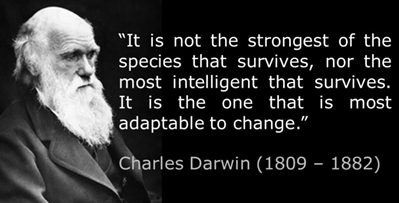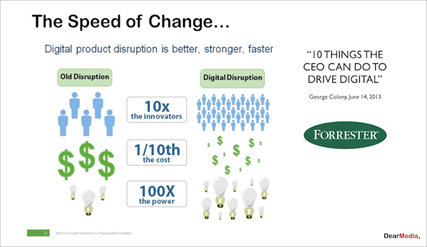The Twin-effect of Speed of Change & Disruptive Innovation: Part 1 – Considerations for OCM
Publish Date: February 16, 2018Change, Alter, Vary, Modify, Update – all synonyms, indicate the commonality of Constancy involved in the adage. Quoted by Pre-Socratic Greek Philosopher, Heraclitus, – ‘Change is the only Constant’. As such, adaptability to the constancy involved is also a determinant or indicator of Success.


So, what is key to success is the, ‘Adapt and Adopt’ aspects to change. It again gets tricky based on what is deemed a ‘Success’ for the change and the driving factor for the change. When again, seen from a different perspective, is indicative of evolution and evolution for good.
So, is change always good? or bad? It differs from the lens being watched, depends on the purpose of the change and the way it is implemented. Through times bygone and from a human perspective; response or reaction to change is generally seen as prone to resistance and as spawning out of revolution.
Evolution or Revolution?

Ironically, change is involved in certain sub-conscious activities of the human mind too, which we perform as part of our daily routine or a formed habit. For instance, consider a scenario of variable traffic congestion that is certain to hit us in our commute to work. Most often, we more than welcome this change, accept the variability involved in this change if it were to occur, thereby considering it as part of our stride. But, would be resistant to changes that could impact the beliefs and thinking patterns that would involve a role change, a company change, changes in any materialistic aspects of our lives.
70% Failure Rate!!! Is it True or a Myth?
As we continue to discuss, we land into an interesting scenario. A search on google for “70% failure rate” yields over 1.96 million results and has the famous headline statements from McKinsey, IBM, HBR, Forbes etc., [3] thus outlined –

- McKinsey and Company – “A recent survey of business executives indicate that the percent of change programs that are a success today is… still 30%.”
- IBM – “Nearly 60 percent of projects aimed at achieving business change do not fully meet their objectives.”
- Harvard Business Review – “The brutal fact is that about 70% of all change initiatives fail.”
- Forbes/Towers Watson – “A new study by Towers Watson has found that only 25% of change management initiatives are successful over the long term.”
- Connor Partners – “Change practitioners have some culpability for the atrocious 70% failure rate of change initiatives.”
Wow! This info is alarming! Is this a myth? Or does it involve some truth?
The answer is a, ‘Yes’ & a ‘No’ as change journey takes through natural steps in the transformation process as it involves a cycle of trying to do something in a different manner, in the process either succeed or fail, in the event gather learning and go again.
The definitions of Success and Failure can again be defined differently, against a set of measures on what is essential for the transformation journey that calls out the Massive Transformative Purpose (MTP) for the change initiative. The transformation could involve a change in technology or platforms, or in mindsets of people, changes on process front, system front, or a combination. To measure Success or Failure of the change initiative, it is usual to evaluate against a set of Business Objectives derived from the devised Vision & Mission for change initiative.
If you are a reader of this blog with an answer as, ‘Yes, 70% failure rate is a myth’; you may find the ensuing information as agreeable –
- The definition of change project is questionable
- The definition of “success” is questionable
- Success is measured at the wrong time
- The units of analysis are not the same
However, to the readers with an answer as, ’No’ – the failure could be 40%, 50%, etc. & a 70% as on higher end?”. Nothing wrong as well from this perspective.
Continuing into his article [3], Ron Freeman reflects on some of the headline statements from some of the most influential sources of business information and attributes the myth to how we measure success/failure in the context of change initiatives and outlines specific guidelines that could be helpful towards measuring the Success of change initiatives. This could help the readers with a, “NO’ answer on other perspectives on looking into the interpretation.
John P Kotter, regarded as Leadership & Change Management guru, quoted – “The rate of change is not going to slow down anytime soon. If anything, competition in most industries will probably speed up even more in the next few decades.”
Then, where do we start on the Inevitable?
Now, in looking at the myth of 70% failure rate as 2-sides of the coin, where do we start on the inevitable? The inevitable CHANGE Initiative.

In looking at the change initiative and the transformational journey for the Organization, Gary Hamel’s (Management Expert) address at the 6th Global Peter Drucker Forum in Vienna, Austria in Nov’ 2014 would serve as an alerting beacon – “The most profound business challenge we face today is how to build organizations that can change as fast as change itself.”
What does the present day have to offer for today’s Businesses?
In today’s world, we come across a lot of buzzwords like Disruptive Innovation, Speed of Change, Gamification, etc. amidst a requirement to maintain a balance between stability and disruption. Stability regarding what-is working to that of disrupting to new ways of working.
We find either individuals or Organizations at this cross road. So, what is a best way forward?
Disruptive Innovation is a term which refers to an Innovation that creates a new market and value network and eventually disrupts an existing market and value network, displacing established market-leading firms, products, and alliances
Forrester Research in one of their reports, on speed of change talk about digital transformation as involving a multiplicity of 10 on Innovation, reduction of a tenth in costs and a 100x multiplicity in power as referenced in the figure

As such, the Twin-effect of Disruptive Innovation & Speed of Change warranting transformational journey for today’s Businesses; thereby calls for a look at OCM (Organizational Change Management).
The Transformational Journey & Considerations for OCM (Organizational Change Management) –
Any change does not happen in isolation; it will have its impact on the entire organization. If we were to keep pace with the norms in today’s world on the pace of Disruptive Innovation & Speed of Change, the success of change initiative depends on the change capability of the organization. A change capability that needs a mindset shift enabling Organization Transformation. A mindset shift [2] that involves a move from –
- Profit –> Purpose
- Hierarchies –> Networks
- Controlling –> Empowering
- Planning –> Experimentation and
- Privacy –> Transparency
In continuation as Part 2, this article will lead to transformation shift needed in relevance to Organizational Change Management (OCM) and the Iceberg illusion. The Iceberg that could hit the Titanics of OCM. The caution to be exercised in safeguarding the journey of Organizational change aspiration.
Oh! is the challenge seeming to get even tougher?
Maybe NOT as we land into the philosophical aspect of looking at change as an inevitable aspect of our lives involving constancy. The quote from Steve Jobs would serve the inspirational purpose for the aspirational journey – “Those who are crazy enough to think they can change the world usually do.”
Forbes’s article on, ‘Managing for Disruption’ [1], gets to the point of, ‘Disrupting the Disruptors’ with the statement – “one overlooked aspect of disruption is that disruptors themselves are not immune.”
So, we are good! We are good so long we embark on the journey!

Contact us today to know more about how YASH can help you tackle the challenges that arise during a digital transformation.
Lakshmi Nanduri – Program manger @YASH Technologies
Lakshmi Nanduri
References & Image Credits –
- https://www.forbes.com/sites/gregsatell/2014/04/01/managing-for-disruption/#55103bc11578
- https://www.thoughtworks.com/insights/blog/unfinished-business-organizational-transformation
- https://flevy.com/blog/70-of-change-management-initiatives-fail-really/
- https://conversationsofchange.com.au/70-of-change-projects-fail-bollocks1/

















